Nov. 2010
As we were wrapping up our trip to Red
Hill PA, Bobís wife DeeDee pointed out a collection of green mudstone
slabs along with one carefully guarded slab that had 3 or 4 very nice
hyneria teeth. Some of these slabs had some halfway decent looking plant material
exposed and we were told to take what we wanted. I saw one that looked
like it would make an interesting stepping stone so in the
car it went.
A week or so later I took a chisel to flatten out
the bottom and notice just a small bit of bone. Another good whack
exposed more and it looked like additional material was still hidden. A
ball peen hammer and some finishing nails were next, a few hours
later I had enough exposed to know this looked odd. I was hesitant to do
any further prep work until I was sure of what I had. My research
drew a blank, so I took a few pictures and and sent them off to a
contact name I found on the Red Hill website.
I'll stop here and let an article from the DVPS newsletter take
over....
DVPS newsletter 01/27/2011
REPORT ON RECENT RED HILL FIND
Field Trip Coordinator - Larry Decina
A pelvic girdle of an early tetrapod or just a pectoral
plate of an acanthodian from Red Hill?
DVPS Member John Whitley attended the Red Hill Trip
in November. After the trip he noticed the tip of bone in a
slab of plant material he had thrown in the car as he was
leaving Red Hill. After uncovering some of the bone
himself, he contacted Dr. Ted Daeschler at the Academy
of Natural Sciences about his find. |
of our incredible fossil preparator here at the Academy
of
Natural Sciences? I think that it might have scientific
interest. If so, would you be willing to donate it to the
museum for further research with your name attributed as
the discoverer? We ask such when people collect at Red
Hill, an active research site."
A few days later, Dr. Daeschler followed up with "It will
be very exciting if my first impression is right on this.
Although we have a variety of early tetrapod elements
from Red Hill, a pelvis would be a very interesting
addition! Thank you for your willingness to keep it
available for science now and in the future. Thanks
especially for treating the specimen carefully, preserving
surrounding matrix, and asking the right questions." |
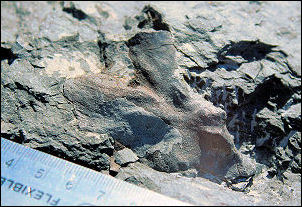 |
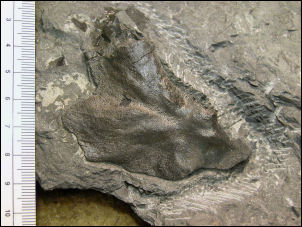 |
|
ANSP 23239 after partial prep work by
John Whitley |
ANSP 23239 being prepped at the Academy |
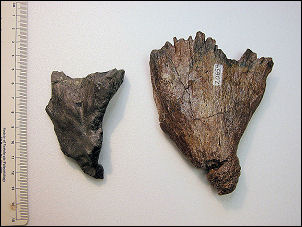 |
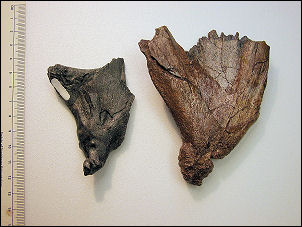 |
|
ANSP 23239 (left) and Gyracanthus
Pectoral Plate (right) |
ANSP 23239 (left) and Gyracanthus
Pectoral Plate (right) |
Newsletter photos.
(click to enlarge)
Dr. Daeschler replied "I
really appreciate your interest in
Red Hill fossils, and your instinct to ask about the
specimen in the block you collected. It does seem very
interesting! It is not a typical bone from Red Hill. I think
that it is possibly part of the pelvic girdle (hips) of an
early tetrapod (but that is a wild guess at this point).
Would it be possible for us to find a way to get it in front |
After the fossil was fully
prepped out at the Academy a
few weeks later, Ted follow up with ďFred has now
prepared the specimen in 3-D and Iím sorry to report that
ANSP 23239 has dropped down a notch, going from an
early tetrapod pelvis to a pectoral plate of an acanthodian
fish. The anatomy of the specimen on the surface that
was exposed when you found it is certainly unique, and
unlike any other acanthodian pectoral plate in our
collection, but once the entire element was exposed, the
conclusion is clear. Iíve attached photos of the two sides
of ANSP 23239 alongside the pectoral plate of |

Gyracanthus (acanthodian) from Red Hill.
ANSP 23239 is
still unique and interesting. Iíll forward pictures of it to
some people who work on such critters to ask if it looks
like anything they know of, or if it might be pathological
in some way. I really appreciate the care and thought that
you invested into the specimen. It will remain a part of the
research collection at Academy, with attribution to you.Ē
Even though this specimen didnít turn out to be a pelvic
girdle as Dr. Daeschler had first hoped, this story
illustrates very important point for DVPS members to
keep in mind. As part of our permission for access to Red
Hill for field trips, club members are required to have
Doug Rowe of other Academy personnel review their
finds for rare specimens of scientific value. You never
know, you might end up being credited as the discovery of
a new species! |
|
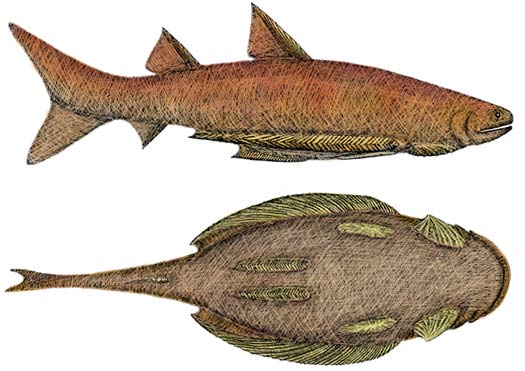
Side and bottom views of Gyracanthides murrayi,
a Lower Carboniferous relative of Gyracanthus
It was certainly an exciting few weeks and I'd be
less than honest if I didn't admit that I was rather disappointed at the
outcome. One of the high points was turning the specimen over to Dr. Daeschler and being
given a guided tour of the
of the Academy of Sciences in
Philadelphia.
ANSP 23239 is the catalog number assigned to this specimen.
As far as I know the exact species has still not been determined
Click here or the Next button at the bottom of the page for pictures from the ANSP.
|




